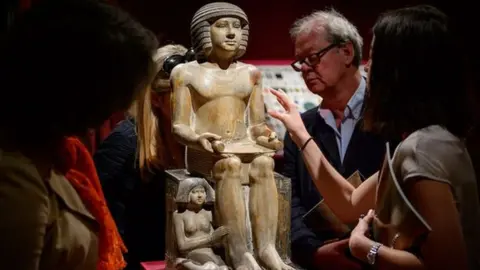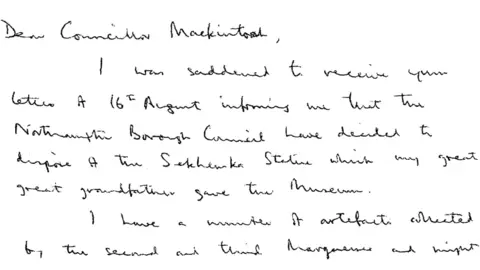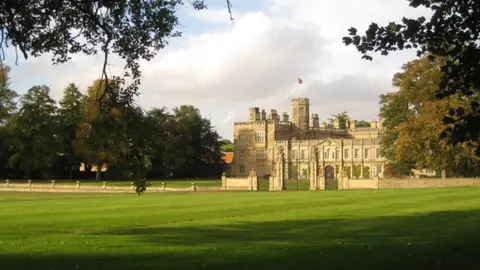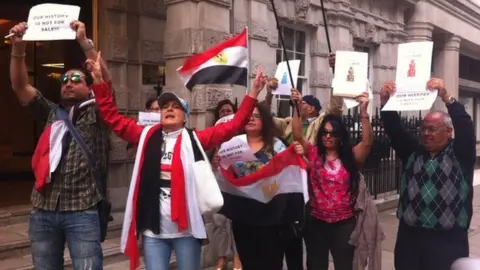Lord Northampton had 'interest' in Sekhemka statue purchase
 AFP
AFPA peer was interested in buying an Egyptian statue before its controversial £15.8m sale and export, newly-released papers have revealed.
The Marquess of Northampton inquired about the 4,500-year-old artefact two years before it was put up for sale by Northampton Borough Council.
Papers show he then became involved in a legal wrangle with the council over its ownership.
It was eventually auctioned in 2014, sparking widespread criticism.
The sale of the Sekhemka statue was condemned in the art world and saw the council thrown out of the Museums Association on ethical grounds.
Lord Northampton - whose family had given the statue to Northampton Museum in about 1880 - received £6,741,000, with £8m going to the council.
He told the BBC he had agreed to the sale because the council "urgently needed the money to pay for substantial repairs to the museum" and that Christie's initial valuation had been up to £2m.
 Marquess of Northampton
Marquess of Northampton "This was the sum quoted to me when I offered to buy it back from them," he said.
"I did not have that sum available to me at the time or might well have acquired it for the family collection."
Documents published under the Freedom of Information Act - revealed by the Local Democracy Reporting Service - detail two years of legal wrangling.
The authority initially planned to reinvest any money raised in Northampton Museum, Abington Park and Delapre Abbey.
In a handwritten letter, Lord Northampton expressed his "sadness" over the proposed sale but said he "might be interested in purchasing the statue".
 Robin Stott/Geograph
Robin Stott/GeographThe papers reveal he changed his mind after being tipped off by a mystery person "about whether the statue was given or loaned to the museum".
Delays in sharing legal advice over its ownership led to Lord Northampton bringing in lawyers to demand the return of Sekhemka and other Egyptian artefacts in Northampton Museum.
David Mackintosh, the Conservative-run council's leader at the time, later offered to meet without lawyers to try to reach an agreement.

A meeting took place at Castle Ashby House, with lawyers present on both sides.
In a later email, Lord Northampton told Mr Mackintosh the council's lawyer was "particularly aggressive".

What is Sekhemka?
- Described by Christie's as "an exceptional Egyptian painted limestone statue for the Inspector of the Scribes Sekhemka", it features a bare-chested, seated figure
- It dates from circa 2,400-2,300 BC and is probably from the Royal Cemeteries in Saqqara
- The 75cm (29in) high statue features his kneeling wife and a man - most probably his son - in raised relief, along with a ceremonial procession of men carrying duck, geese, a calf, lotus flowers and incense
- It was acquired by the 2nd Marquess of Northampton in Egypt in about 1850 and presented to Northampton Museum by one of his sons, either the 3rd or 4th Marquess of Northampton
Source: Christie's

Almost a year after negotiations began, the council leader told Lord Northampton: "While we can obviously work to resolve this difference of view through the courts, I would like to suggest that we might consider an alternative approach.
"If you and I were able to meet on a without-prejudice basis, and discuss the matter directly, we may be able to agree a way to reach a mutually acceptable position."
Mr Mackintosh, who later became an MP in the town, said in another email: "I will be expressly instructing our legal advisor to put forward a proposal for the sharing of the sale proceeds."
The statue is now in the hands of an unknown private buyer and is believed to have been exported to the US.
 Christies
ChristiesNorthampton Museum, which is undergoing a refurbishment with the proceeds of the sale, was stripped of its accreditation by Arts Council England.
Ruth Thomas, who was part of the Save Sekhemka Action Group and worked at the museum, said the sale of the statue was a "dreadful chapter".
"It has opened the floodgates to getting rid of material," she added.
The council declined to comment.
Mr Mackintosh, who became the Conservative MP for Northampton South in 2015. was named Philistine of the Year over the sale of the statue by the Private Eye magazine.
He later stood down as an MP after being criticised over his role in a £10m loan to Northampton Town Football Club, which is the subject of a police investigation. He denies any wrongdoing.
"All of the proceeds [of the Sekhemka sale] went towards the museum and it will be a great asset for the town when it is renovated," he said.
"The issue with Sekhemka was that it had been difficult to keep in the museum because the insurance costs were very high."
